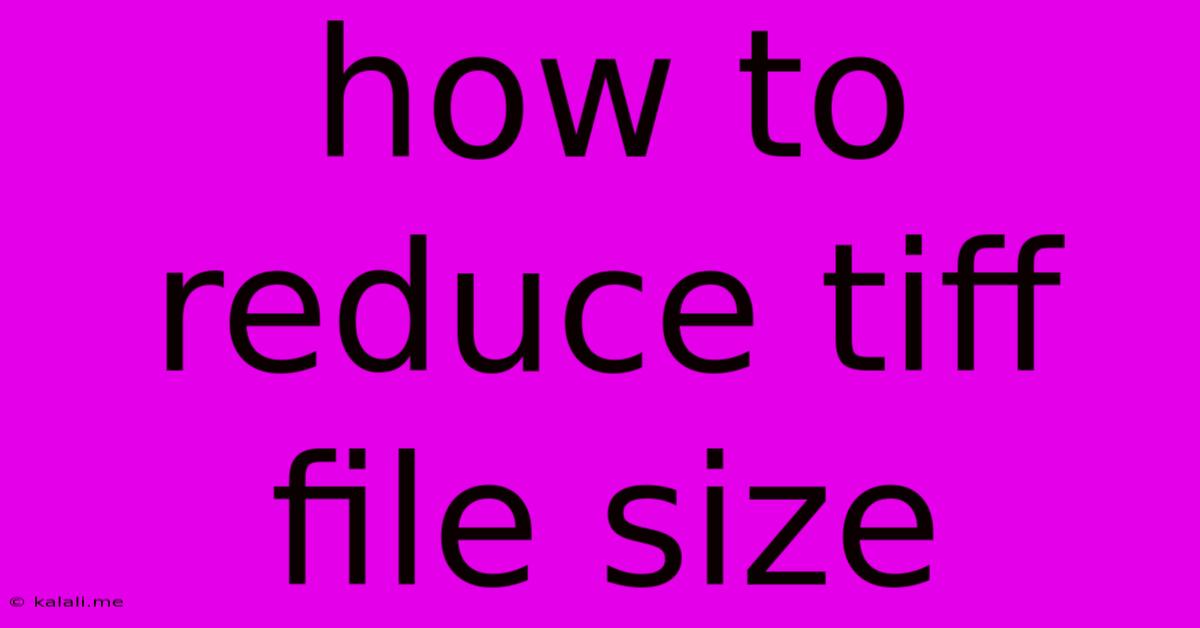How To Reduce Tiff File Size
Kalali
May 29, 2025 · 3 min read

Table of Contents
How to Reduce TIFF File Size Without Losing Quality (or Much of It!)
TIFF (Tagged Image File Format) files are known for their high quality and ability to support lossless compression. However, this quality comes at a cost: large file sizes. This can be problematic for storage, email, and online sharing. This article will guide you through several effective methods to reduce TIFF file size without significantly compromising image quality. We'll cover both free and paid options, catering to different needs and technical skills.
Why Reduce TIFF File Size?
Before diving into the methods, let's understand why reducing TIFF file size is crucial. Smaller files mean:
- Faster upload and download times: Ideal for sharing images online or emailing them to clients.
- Improved website performance: Large images can slow down website loading times, impacting user experience and SEO.
- Reduced storage space: Saving significant storage space on your hard drive or cloud storage.
- Easier file management: Smaller files are easier to manage and organize, improving workflow efficiency.
Methods to Reduce TIFF File Size:
Here's a breakdown of techniques, ranging from simple adjustments to advanced software features:
1. Choosing the Right Compression:
TIFF supports several compression methods, affecting both file size and quality. Understanding these is critical:
- None (Uncompressed): Offers the highest quality but the largest file size. Avoid this unless absolute highest quality is mandatory.
- LZW (Lempel-Ziv-Welch): A lossless compression method that provides a good balance between file size and image quality. This is generally a good default choice.
- PackBits: Another lossless compression method, but generally less efficient than LZW.
- JPEG Compression: While TIFF supports JPEG compression, it's a lossy compression method, meaning some image data is discarded. Use this only if a smaller file size is prioritized over preserving the absolute finest detail.
Choosing the right compression is often the single most effective method. Many image editors allow you to easily change the compression method when saving a TIFF file.
2. Reducing Image Resolution (Pixels):
High-resolution images contribute significantly to large file sizes. If your image contains more pixels than necessary, reducing the resolution can drastically reduce the file size. This is especially true for images intended for web use or print at smaller sizes. Consider these factors:
- Intended use: A photo for a website banner requires far fewer pixels than a print intended for a large poster.
- PPI (Pixels Per Inch): Adjusting PPI (how many pixels are used per inch) lowers the resolution. For web use, 72 PPI is generally sufficient. Print images require higher PPI, but you still might find room for reduction.
Reducing resolution will impact image quality, but often this isn't noticeable at smaller sizes.
3. Utilizing Image Editing Software:
Professional image editing software offers advanced features for optimizing TIFF files:
- Lossy Compression (with caution): Software like Adobe Photoshop allows for applying lossy compression to TIFFs, greatly reducing file size, but remember this means sacrificing some image data.
- Selective Editing: Before saving, crop the image to remove unnecessary areas. This directly reduces the file size.
- Layer Management: If working with layered TIFFs, flatten the layers before saving. This often significantly decreases file size.
4. Using Online TIFF Compressors:
Several websites offer free online TIFF compression tools. These tools often utilize various compression algorithms to reduce file size efficiently. Be cautious when using online tools and only upload images you're comfortable sharing.
5. Converting to a Different Format (if acceptable):
If file size is a paramount concern and the highest possible TIFF quality isn't absolutely essential, consider converting the image to a different format, such as JPEG or PNG. JPEG is best for photographic images, while PNG is ideal for images with sharp lines and text. Remember, this involves a loss of quality, potentially significant with JPEG.
By combining these methods, you can effectively reduce TIFF file sizes without sacrificing too much quality. Remember to always save a copy of your original, uncompressed TIFF before making any changes. Experiment with different approaches to find the best balance between file size and image quality for your specific needs.
Latest Posts
Latest Posts
-
Why Do Computer Screens Look Weird On Camera
May 30, 2025
-
Can You Use Checks With Old Address
May 30, 2025
-
Window Air Conditioners Do They Have To Be Outdoors
May 30, 2025
-
How Long For Deck Stain To Dry
May 30, 2025
-
How To Make Brownies From Cookie Mix
May 30, 2025
Related Post
Thank you for visiting our website which covers about How To Reduce Tiff File Size . We hope the information provided has been useful to you. Feel free to contact us if you have any questions or need further assistance. See you next time and don't miss to bookmark.